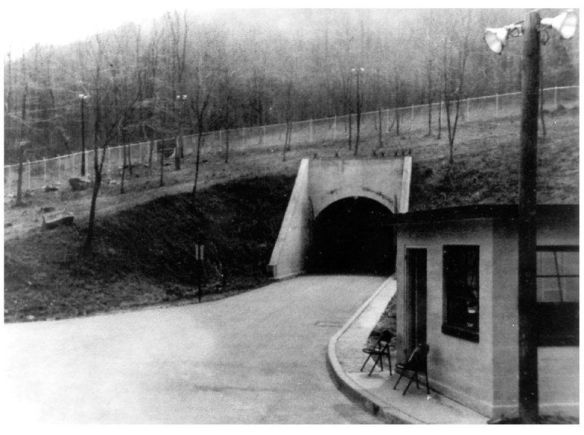One of the portals to Site R.
One of the largest bunkers built during the Cold War would belong not to the White House or FEMA, but rather to the Department of Defense. DoD’s alternate Pentagon is east of Blue Ridge Summit, Pennsylvania, in an underground facility called ‘Site R’. In official jargon, the base is known as the Alternate National Military Command Center but unofficially it is dubbed ‘Harry’s Hole’ after Harry Truman, the President who ordered its construction. Site R is a poorly kept secret since a large amount of information can be found about it on the Internet and it is mentioned in several books on the Cold War.
The ANMCC was built in a mountain called Raven Rock by Parsons Brinckerhoff, a world-renowned New York engineering firm with much experience in large-scale projects (including Cheyenne Mountain in Colorado). As part of its planning, the firm sent engineers to Sweden, Germany and France to visit other underground works and to incorporate some of their techniques into it. Construction began in 1951 and by 1954, the complex was in operation. It is also known as the Alternate Joint Communications Center.
Overall, Site R measures 265,000sq ft and consists of a series of buildings inside caverns that include the same types of rooms as found in other bunkers such as dorms, offices, operation centres and dining facilities. Along with offices for the Secretary of Defense, all three major armed services have their emergency operations centres there. Site R has communications connections with several other COG installations in the Washington area, along with several military facilities in the United States, Canada and Europe. It is fully able to dispatch Emergency Action Messages to nuclear forces should the National Military Command Center in the Pentagon be obliterated. The complex’s power room consists of six 1,000kW generators, and the water reservoir can hold millions of gallons. The base is so large it even has its own chapel, barber shop and convenience store. In the 1960s, it was hardened to withstand 140psi of pressure. Upon its opening, it was made a lodger unit of Fort Ritchie but with the Fort’s closure in 1997, it is now a sub-unit of Fort Detrick. Most of the personnel reside at Fort Detrick and are shuttled in by bus daily.
n the 1980s, 350 were said to work at Site R, but with the end of the Cold War, this number was reduced after it stopped operating on a twenty-four-hour basis. Many of those who work there belong to the US Army’s 1111th Signal Battalion, whose motto of ‘Masters of the Rock’ gives a clear idea of the kind of installation they work in. Other staff include naval, Air Force and Marine Corps personnel, along with sundry civilians. The ANMCC is fully connected to Mount Weather as the latter was designed to serve as backup to the former if it was destroyed.
From access roads, one sees only fences and an antenna on top of Raven Rock. There are absolutely no signs announcing Site R’s presence, save a small green one by Route 116 describing a small building nearby as ‘Site R Wastewater Treatment Plant’. A sign by the rear exit on Cove Hollow Road identifies it as the AJCC and warns that persons making sketches or taking photographs will be detained. In some places, Cold War secrecy is alive and well.
